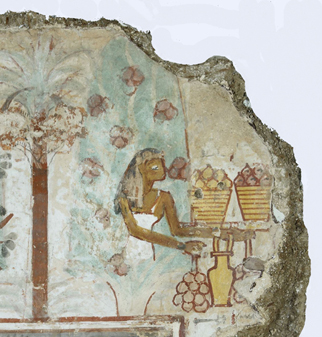5.1 Exploration
The key to the meaning of the scene can be observed in the top right-hand corner (Figure 24).

There is the top half of a female figure, in a white dress, with baskets piled with fruit and a yellow jar containing something to drink. A closer look shows that the figure is emerging from a sycamore fig tree. This is a long-established Egyptian tradition relating trees to goddesses, such as Nut.
Egyptologists have concluded that in this case the goddess is Nut, associated with the sky and with rebirth. What she is doing is welcoming Nebamun into the ‘garden of the west’. That is to say, the garden is not of this world. The west, where the sun sets, was regarded by Egyptians as the land of the dead (hence the location of a necropolis such as the Valley of the Kings, or that at Saqqara adjacent to the administrative capital of Memphis, on the west bank of the Nile). The scene represents the arrival of Nebamun into the afterlife.
In so doing, it in effect concludes the surviving cycle of the tomb-chapel’s decorations.
